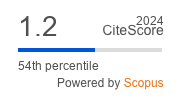Digital Information Infrastructure and the Growth of Chinese SMEs: An Institutional Co-construction Approach
DOI:
https://doi.org/10.52152/22.3.72-79(2024)Keywords:
Entrepreneurial Ecosystem • Institutional Support • SME Innovation • Information InfrastructureAbstract
Purpose: This study investigates how digital information infrastructure (DII) drives the growth and innovation of Chinese small and medium-sized enterprises (SMEs) through an institutional co-construction approach, examining the mechanisms by which information and communication technology enhances SMEs' participation in global value chains (GVCs).Design/Methodology/Approach: A dynamic panel model was employed for empirical analysis, exploring the relationship between DII adoption and SME performance indicators from 2020 to 2024. Structural equation modeling was utilized to analyze pathways through which the integration of informatization and industrialization affects value-added capabilities across different manufacturing value chain segments.Findings: Results demonstrate that DII significantly enhances SMEs' competitive positioning in GVCs through dual pathways: first, digital technologies optimize internal management and decision-making processes (path coefficient=0.65), facilitating product and service diversification; second, DII improves information transparency and reduces transaction costs (average reduction of 23.7%), strengthening supply chain collaboration. The highest combined effects were observed in marketing (47.7%) and quality control (40.6%) activities.Conclusion: The institutional co-construction of digital infrastructure and enterprise innovation creates a virtuous cycle that accelerates the transformation of the manufacturing sector, exhibiting a two-quarter lag before maximum benefits materialize and helping SMEs overcome resource constraints and low-end lock-in challenges.Practical Implications: These findings provide empirical support for policymakers to enhance targeted infrastructure development through technology adoption incentives, innovation vouchers, and digital ecosystem incubators that address the specific developmental stages and technological readiness of SMEs.
References
FIDEA SIA: The assessment of industry growth potential. Riga, 2014. Available at: http://www.svrk.gov.si/fileadmin/svrk.gov.si/pageuploads/SPS_predstavitve/Fidea_2014_-_SI_Industry_Growth_Potential.pdf
GODC (Government Office for Development and Cohesio Policy): Slovenia’s Smart Specialization Strategy. Ljubljana, 2015.Available at:
http://www.svrk.gov.si/fileadmin/svrk.gov.si/pageuploads/SPS_predstavitve/S4_dokument_2015_october_eng_clean_lekt.pdf
Jaklič, A. et al.. Evalvacija izvajanja politike podjetništva in konkurenčnosti v bdobju 2004-2009. Ljubljana, 2012. Available at:
http://www.mgrt.gov.si/fileadmin/mgrt.gov.si/pageuploads/DPK/CRPi_2010/Koncno_porocilo_CRP_konkurencnost.pdf
KUMAR, A., ŠLANDER, Sonja. The EU cohesion policy as part of the development policy in Slovenia. V: KANDŽIJA, Vinko (ur.). Absorption capacity of EU pre-accession programs in the Western Balkan countries Cemafi International, 2014,
Jaklič, A. et al.. Evalvacija izvajanja politike podjetništva in konkurenčnosti v bdobju 2004-2009. Ljubljana, 2012. Available at:
http://www.mgrt.gov.si/fileadmin/mgrt.gov.si/pageuploads/DPK/CRPi_2010/Koncno_porocilo_CRP_konkurencnost.pdf
Downloads
Published
Issue
Section
License
Copyright (c) 2024 Lex localis - Journal of Local Self-Government

This work is licensed under a Creative Commons Attribution-NonCommercial-NoDerivatives 4.0 International License.








